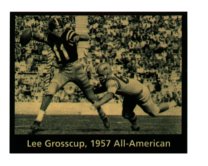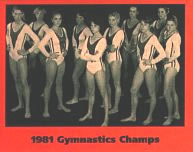
VOL. 9 NO. 3 THE MAGAZINE OF THE UNIVERSITY OF UTAH WINTER 1999-2000
Continuum Home Page - University
of Utah Home Page - Alumni
Association Home Page
Table of Contents
True Grit
Plenty of wins and losses have been chalked up since
athletics at the U began in 1892, but through them all one thing remains
unchanged: the spirit of the athlete.
by John Mooney
In the old carnival and state fair days, hucksters would offer the Lord's Prayer engraved on the head of a pin. Trying to touch all the bases in 150 years of intercollegiate sports at the U in a few pages makes the original pinhead engraving a cinch.
Football and track started in 1892, with the football team losing to Utah State. But the University's first taste of national exposure came in 1916 when the basketball team won the National AAU championship in Chicago, beating the Illinois Athletic Club in the final game. The coach was Nelson Nordgren, who also coached the football team from 1914-17.
 Most
of the coaches doubled up in football and basketball in those early years.
Fred Bennion, Nordgren, Tommy Fitzpatrick, and even Ike Armstrong coached
both football and basketball.
Most
of the coaches doubled up in football and basketball in those early years.
Fred Bennion, Nordgren, Tommy Fitzpatrick, and even Ike Armstrong coached
both football and basketball.
Armstrong is Utah's winningest football coach, with a record of 141-55-17
and 12 conference championships. Vadal Peterson BS'20 MS'46, who replaced
Armstrong as basketball coach in the 1927-28 season, led the Utes to the
NCAA championship in 1944 and the National Invitation Tournament title
in 1947. Those 1944 Utes, after beating Dartmouth 42-40 for the NCAA crown,
defeated the NIT champion St. John's 43-36 in a special playoff to raise
money for the Red Cross.
The early basketball and football teams competed against the best. Armstrong,
for example, opened his career as Ute coach against the University of
Southern California. In 1938 Armstrong sent the team to the Sun Bowl.
Coach Ray Nagel's Utah squad gained national recognition by whipping West
Virginia in the Liberty Bowl, playing indoors in Atlantic City, N.J.
But perhaps the most memorable game came in 1957, "when we beat
Army." It's true that the passing of Lee Grosscup ex'60 and the receiving
of Stu Vaughan BS'59 shocked Army, but the Cadets still won, 39-33. Coach
Jack Curtice died believing he had beaten Army at West Point.
Utah football was competitive under the coaching of Curtice (45-32-4),
Nagel (42-39-1), Bill Meek (33-31), and Wayne Howard (30-24), but Coach
Ron McBride has rekindled enthusiasm with a 68-45 record, four bowl appearances,
six straight winning seasons, a 10-win season and a No. 10 final national
ranking in 1994.
Under Coach Peterson, the Ute basketball team played an early season schedule that included most of the prestigious basketball teams in the East and Midwest: Duquesne, St. Joseph's, St. John's, Canisius, Villanova, Ohio State, Michigan, LaSalle, and Cincinnati, all on the road, in addition to the major opponents on the West Coast.
Coach Jack Gardner took the Utes to the Final Four twice, losing in the battle for third place to St. Joseph's and Duke. In the 23 years that followed the war, the Utes had only three losing seasons. Coach Gardner's record is 339-154 with seven conference championships.
On the local scene, few Ute fans will forget the great victory over Ohio
State, a talented team that included Jerry Lucas, John Havliceck, and
Bobby Knight. Memorable, too, was the 1979 NCAA Final Four hosted by Utah.
The final game featured Magic Johnson against Larry Bird.
Basketball has boosted its national stature under Coach Rick Majerus,
with 210 victories and only 59 losses. Since Majerus took over in the
1989-90 season, Utah has appeared seven times in the NCAA and once in
the National Invitational Tournament competition, with the highlight being
meeting Kentucky in the 1997-98 championship finals.
Skiing, which now ranks with women's gymnastics as the sport with the most national championships, developed from the ski jumps at Ecker Hill. The first NCAA ski championship was in 1954. In 1948 and 1952, Utes Dick Movitz BS'49, Jack Reddish, Susie Rytting Harris, and Devereaux Jennings competed in the Winter Olympics and also brought Utah its first intercollegiate ski title. Later Ute Olympic skiers included Jean Saubert ex'69 and Margot Walters McDonald ex'64 in 1964, Karen Corfanta in 1968, and 17 others. Since Pat Miller assembled his coaching staff in 1977, the men's and women's skiers have together won eight national championships, and the men, one national championship in which the women did not prevail.
 Women's
gymnastics came into the fore as a result of the implementation of Title
IX and the arrival of Coach Greg Marsden. The Lady Utes have won 10 national
championships, far more than any rival. Utah has competed in the nationals
23 times and, since NCAA competition for women began in 1982, has won
nine of the 16 team titles.
Women's
gymnastics came into the fore as a result of the implementation of Title
IX and the arrival of Coach Greg Marsden. The Lady Utes have won 10 national
championships, far more than any rival. Utah has competed in the nationals
23 times and, since NCAA competition for women began in 1982, has won
nine of the 16 team titles.
Swimmers under Coach Don Reddish ex'50 won 22 conference championships. Jeff Rolan BS'78 became the first swimmer in the conference to win an NCAA championship, with his performance in the butterfly.
Utah track and field can boast of Blaine Lindgren BS'62, silver medalist in the hurdles in the 1964 Olympics. Scott Bringhurst BS'74 MS'75 won All-American honors in distance running and cross country in 1973. Fred Sheffield BA'45, although more publicized as a basketball player on the national championship team, won the national indoor high jump championship twice. But the track and field highlight is the hosting of the 1947 NCAA championships, which featured hurdler Harrison Dillard, sprinter Mel Patten, and middle distance star Herb McKenley.
On the court, Greg Holmes BS'95 won the national singles title for the
Ute tennis team in 1983.
Over the years, conference alignments changed from the Rocky Mountain
Conference to the Big Seven, then to Mountain States (Skyline) and the
Western Athletic Conference in 1972. The WAC, which had expanded too much,
broke up with the formation of the Mountain West Conference in 1999.
By all accounts, the biggest change in college athletics has been the emergence of women's sports and gender equity in athletics under the prodding of the federal government. Title IX of the Education Amendments of 1972 prohibits sex discrimination in federally assisted education programs. Before its passage, athletic scholarships for college women were rare, no matter how great the athlete's talent. Title IX meant no more cookie sales to raise money for Ute women's athletics, and no more sleeping in station wagons at away events. Today, college women receive about one-third of all athletic scholarship dollars.
No one questioned that women athletes deserved a more level playing field, but it took time and effort to improve the opportunities for young men and women in college athletics. Consider: Utah's two national basketball championship teams (1916 and 1944) had just one player who received financial help. One player said Coach Peterson told him to bring his own basketball shoes when he reported.
In football, the U helped arrange for summer jobs for players at Fisher Brewery, Kennecott Copper, and Broyles Brothers Drilling. The latter involved working in Alaska and was the moneymaker, because there was no way to spend one's earnings. Einar Nielsen (the trainer), Spide Morris BA'27, and a couple of other boosters would raise a few dollars from downtown contributors to help an athlete financially, or a good athlete might get the towel concession in the training room.
In 1940 I crusaded to get a training table to provide an evening meal for players during the football season. The grant-in-aid, full scholarships, and federal grants for impoverished athletes came much later.
Today, all the men's and all but two of the women's sports are funded fully, and Chris Hill MED'74 PhD'82, the athletic director, says the sports budget is $15.5 million. In addition to gymnastics and skiing, women compete in softball, soccer, volleyball, swimming, tennis, basketball, and track. To balance the budget and match the numbers for women's sports, Utah dropped wrestling several years ago, and the men's track and field program has been cut back to distance running and cross country.
To help meet costs, the Crimson Club has a budget of $3.2 million, and the University merchandises its products, charges extra money for premium seats, installed luxury boxes in the stadium, and competed for television and radio revenue.
Women's athletics are producing cham-pionships aside from gymnastics. Before the NCAA embraced all sports, Ute women won the Association of Intercollegiate Athletics for Women championships in skiing and cross country. The softball team has competed in two World Series. The women's basketball team has won three straight conference titles. Considering that the major emphasis and funding for women's athletics is only 25 years old-compared to the 100-year span of men's athletics-the progress has been remarkable.
Of course, individual sports will continue to come and go. Intercollegiate polo was dropped when the University ROTC followed the military trends in World War II and eliminated the horses. No animals meant no polo teams. For once a losing coach could alibi, "I just didn't have the horses."
-Former Salt Lake Tribune Sports Editor John Mooney covered University of Utah athletics for 51 years. He previously wrote for Continuum about the University's centennial season of football.
|
Pride Of Place The coaches' offices were on the street level on the south side of the building, while across the foyer to the north, Ted Jacobsen BS'52, Monty Howard ex'55, and Ruth Joseph ex'56 handled ticket sales. The basketball court was the centerpiece on the second level, but the eastern end of the building could be used in a limited way by the football and baseball squads. Track athletes could run laps around the basketball court. Since the football coaches between 1925 and 1957 also doubled as athletic directors, there was no need for a special administrative office. And since most of the assistant coaches also coached other sports, the whole department was able to cram into that area. With the Jon M. Huntsman Center providing excellent facilities for athletes, coaches, and spectators for basketball and any indoor sport requiring ample seating, and the Ute Natatorium providing a home for the swimmers and divers, the physical plant began to gain stature. The surrounding land was put to use for classrooms and office space for the Exercise and Sport Science Department, and the complex came to be known as HPER (Health Physical Education Recreation). Other new structures and facilities include the George S. Eccles
Tennis facility, the Dee Glen Smith Athletic Center, the Thomas
Kearns McCarthey football practice field, the Ute softball field,
the Crimson Court for volleyball, the Ute soccer field, and the
plastic bubble for indoor practice. In addition, the training room has been renovated, and a new baseball field will be ready next year. And the Kenneth P. Burbidge Jr. BS'55 Family Athletics Academic Center will be ready in the fall of 2000. —J.M. |
Continuum Home Page - University of Utah Home Page - Alumni Association Home Page - Table of Contents
Copyright 1999 by The University of Utah Alumni Association